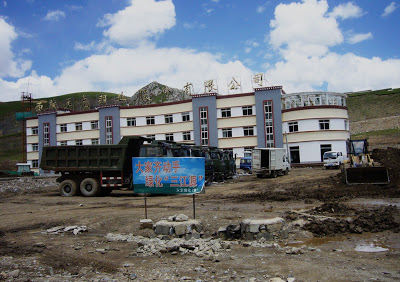High Peaks Pure Earth has translated a blogpost by Woeser written on June 22, 2013 for the Tibetan service of Radio Free Asia and published on her blog on June 24, 2013.
The blogpost follows up on the previous article “Chamdo: Village and Monasteries are Covered in Five-Starred Red Flags”, an article that attracted attention from this Washington Post blog and was tied to recent incidents in Driru county in Nagchu.


Chamdo: “If They Obstruct Mining, Monasteries Will be Closed and Villagers Arrested”
By Woeser
According to reports from local people, the Chamdo region now disallows any work unit employees, students or retired workers to spin prayer wheels or pray. All religious festivals are even more heavily controlled. Not long ago was the month of the Buddhist festival “Saga Dawa”. The local authorities called in an urgent meeting and issued a notice strictly prohibiting any Buddhist rituals. Students were warned by their teachers not to go to a monastery and pray, nor to wear “sungdu” (cords given by senior monks as blessings), otherwise they would be severely punished. The Tibetan language teaching in schools in the Chamdo region is also very bad, one can hardly find a student who can even keep a diary in Tibetan these days.
One school in Guro Township, Chamdo County, used to have a statue of the ancient Buddhist figure Thangtong Gyalpo, it used to be standing inside the campus but was affected by many years of large-scale expansion. Last year, the prefectural Party secretary Norbu Dhondup came into office and said “Party schools are unrelated to Thangtong Gyalpo” and sent in excavators to dig out the statue and throw it into the river. Local people all cursed this, saying that the Cultural Revolution had returned and that local authorities were even worse than the Red Guards.
In Chamdo, like in Lhasa, large construction projects are being carried out in the name of “urban development”. At the moment they are building a “liberation Square” in memory of the “Chamdo battle” of 1950, additionally, they are planning to erect a group of “Chamdo Liberation” statues of the People’s Liberation Army.
Mines have also been opened in Chamdo and hydroelectric power plants been set up everywhere. The Yulong copper mine that has been exploiting minerals for the past almost 10 years is situated in Chunyedo Township, Chomdo County, Chamdo Prefecture, its copper reserves are believed to be “second in the whole country”. Many large central Chinese companies such as Chinalco are operating here.
As the Tibet Daily reported, on March 20, 2013, Chamdo Prefecture held a general meeting on the development of the mining industry at which the member of the Standing Party Committee of the TAR and Party Secretary of Chamdo, Norbu Dhondup, pointed out that it has already been discovered and verified that 6 different types and 53 different classifications of ore in 714 mining areas exist in Gangdise – in the Dangla mountain range mining area, Panggong Lake – in the Nujiang River mining area, Southern Jangtang – in the Zogang mining area, in Northern Jangtang – in the Chamdo mining area. What the party newspaper did not, however, report on was that Norbu Dhondup added another sentence: “If they obstruct mining, monasteries will be closed and villagers arrested”.
In Markham County, Chamdo prefecture, Tibetans have been resisting against the mining activities of the ZK Group for many years. Not only did they mine in the sacred mountain, even worse is that the chemical elements utilised to clean the minerals have been discharged into the river water, poisoning local fish stocks, leading to cattle and residents being infected with strange diseases. Between 2005 and 2009, in Tsangshö Township, Markham County, 26 people and 2442 cattle and sheep died from poisoned drinking water. In April 2009, 500 young Tibetans lay down on the street day and night, obstructing the mining activities of the ZK Group. When the local authorities sent in military police to disperse the protestors, 2000 men and women, the young and the elderly, simultaneously went out to sleep on the streets. The head of the TAR, Pema Thinley, protected by 27 police and military cars, went down to the mining area and said to the protestors: “The water has not been polluted at all, you have been making up facts, you are obstructing the mining, violating the central policies of developing the western areas. The consequences of this are quite severe, are you aware of this?” At that time, an elderly man took a bowl of water and gave it to him, saying: “if you dare to drink this bowl now, we will not sue you.” The angry Pema Thinley poured out the water, slapped his hand on the table and threatened: “Do you want to revolt?” and the villager shouted: “Down with Pema Thinley! We will use our lives to protect the sacred mountain!”. Pema Thinley had to leave the area in a hurry. After a few months of protests, the ZK Group was forced to temporarily stop mining. But after some time they started again, continuing to pollute the environment. Last year in August, almost 2000 local people gathered together to once again protest against the mining. Military police opened fire, a Tibetan called Nyima was shot dead, 6 other people were injured.
On July 3, 2012, in Pütog Township, Dzogang County, Chamdo Prefecture, 9 Tibetans were arrested because they protested against mining.
In Dagyab County, Chamdo Prefecture, mining activities and blasting operations obstructed the pathways for local people to bring their cattle to the grazing areas; also, the mining polluted and damaged large patches of farmland. Local people turned to the relevant departments to request the termination of mining numerous times, but no one listened.
Today, in Lhato Township, Chamdo Prefecture, the hometown of the 17th Karmapa Rinpoche, the opening of a mine is in preparation, it is said that this one is mainly a gold mine. Menda Township possesses lead and zinc and is also about to be subjected to mining activities.

Chamdo Prefecture administers 11 counties, according to the Tibetan Daily, until the end of 2012, 99 hydroelectric power plants and 89 photovoltaic power plants have been or are being built in this area. And this does not even include any small-sized power plants. The Guoduo hydroelectric power plant, located on the upper reaches of the Mekong River in Tserwé Township, is the so far largest power plant in the Chamdo Prefecture, it was designed and constructed by Powerchina and is the so far biggest scavenger of energy resources in Tibet. A Chinese scholar who has just been to Chamdo said to me that there are too many small-sized hydroelectric power plants along the river, leading to the river water becoming muddy and to the severe destruction of the ecology.
Chinese people migrating to Chamdo are also increasing, even caterpillar fungus harvesting areas have been occupied by Chinese. There are many Chinese cadres doing business with caterpillar fungus. Tibetan traders, on the other hand, because of travelling restrictions, can only sell caterpillar fungus locally, having to put with the cheap prices of the Chinese or Hui traders; this is extremely damaging but there is nothing that Tibetans can do about it.
June 22, 2013





Follow Us!